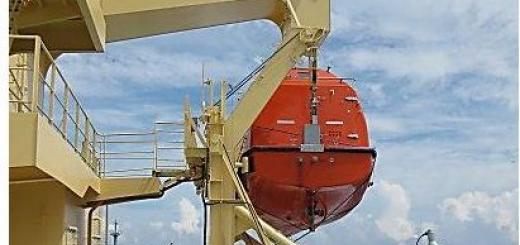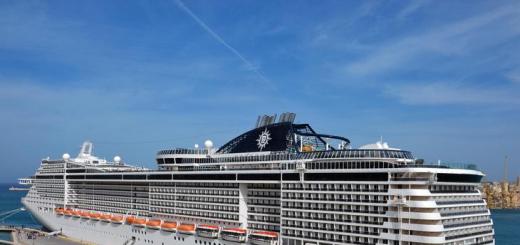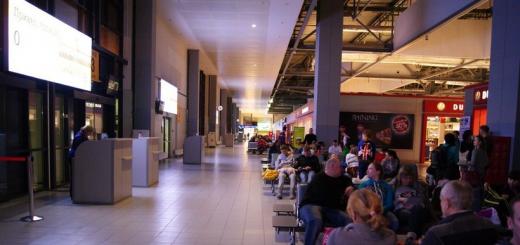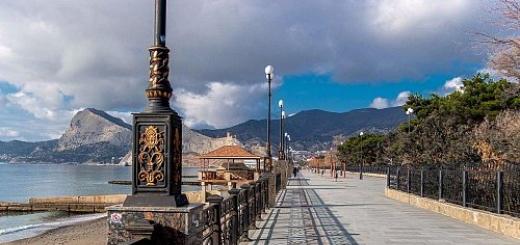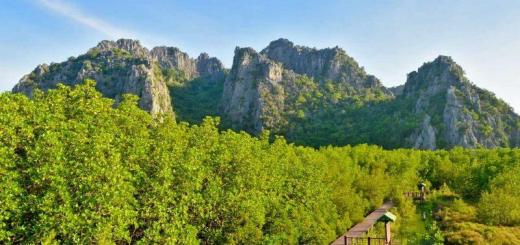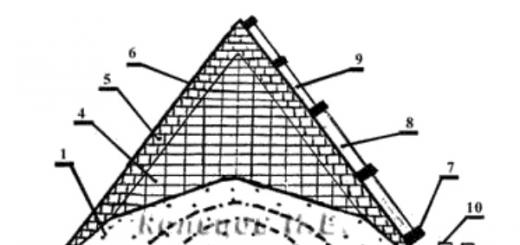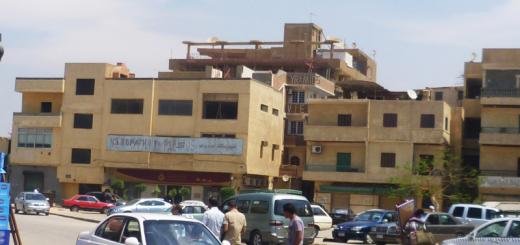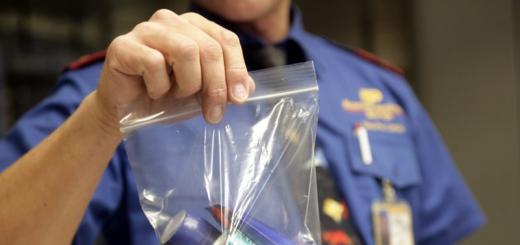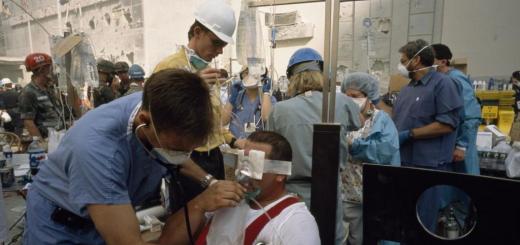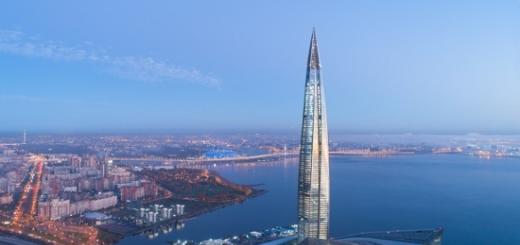Masada (Israel) - description, history, location. The exact address, phone, website. Reviews of tourists, photos and videos.
- Tours for the New Year around the world
- Hot tours around the world
Previous photo Next photo








The ancient fortress of Masada is located near the city of Arad. It stands on a rock in the middle of the desert, at an altitude of 450 m above sea level, on a flat plateau measuring approximately 300 by 600 m. The first historical building in this secluded place was a fortified shelter built by King Herod I in 25 BC. e. But not the first creation of human hands: about 10 years before that, an ancient fortress had already been built here.
Herod the Great created stocks of food and weapons in the fortress, brought water here, and equipped Roman-type baths. Here he kept his golden treasury. No wonder: it was very difficult to get into Masada, and it was impossible to go unnoticed. It is surrounded on all sides by steep and impregnable rocks, and only along a narrow path from the side of the sea can one climb up. But this was not enough for Herod: he surrounded the plateau with thick walls, the total length of which is almost 1.5 km, and the thickness is 4 m. 37 towers were also built in the walls.
The fortress was included in the UNESCO World Heritage List.
Even after the Romans conquered Jerusalem, the defenders of Masada (in the amount of a thousand people - and this, along with children and women) held for another three years.
Inside the walls were royal palaces, storehouses and warehouses, water tanks and other household buildings, as well as a synagogue. Today, from all these structures, you can see the palace of Herod, the baths, several other ruins and a synagogue. The latter is especially surprising: earlier scientists believed that the Jews did not need a synagogue at that time, since they had one temple.
Fortress Masada
The fortress fell not as a result of an attack from the outside, but during the internal uprising of the Zealots that took place in 66 AD. e. All the Romans were exterminated. The Jewish War began, but even after the Romans conquered Jerusalem in 70, the defenders of Masada (in the amount of a thousand people - and this, along with children and women) kept for another three years. The Romans needed about nine thousand slaves alone to build a rampart around the fortress and pave the way for siege engines.
The defenders of Masada did not surrender to the enemy: by lot they chose a dozen people who killed them, and then each other.
The ruins of the fortress were found in 1862. Full-fledged archaeological excavations began here in the 1960s. The most interesting buildings preserved here are the Western and Hanging Palaces. Today, Masada has become a popular tourist attraction, as evidenced by the presence of a cafe-bar and the opportunity to spend the night on the west side of the cliff with an organized group. In the summer, a light and music show is shown on the same side.
Fragments of ancient mosaics have been preserved in various buildings of Masada.
Practical information
The fortress is located near the Ein Gedi - Ein Bokek highway, at south coast Dead Sea. You can get to it by funicular from the station of the same name on the Dead Sea.
To see the light and music show, you need to drive up to the fortress by car from the direction of Arad.
The fortress of Masada is the royal citadel of King Herod, which became the last bastion of the Zealots during the Jewish uprising. The most tragic events in the history of the Jewish people took place here - the rebels preferred mass suicide in order not to fall into Roman captivity.
Myths and facts
No one knows for sure what is fact and what is fiction, but the story of Masada intrigues with its dramatic nature.
On a high cliff in the middle of the desert, two thousand years ago, a Jewish noble named Herod sought refuge for himself and his family. He supported the Romans in the war with the Parthians, and when the Parthian became king of Jerusalem, Herod, fearing retribution, fled to the mountains. He then went to Rome, where the Roman Senate appointed him king of Judea. Herod returned, accompanied by two Roman legions.
Fearing rebellion and overthrow, King Herod built a citadel on top of a mountain in 37-31 BC. Masada means "fortress" in Hebrew. The fortress was equipped and supplied with everything necessary for the life of a large army during a long siege. Massive warehouses and fortified palaces with a labyrinth of passages ensured a safe retreat in case of war.
But Herod never had to test the strength of the citadel. After his death in 4 BC, the fortress was inherited by his son Archelaus. A few years later, Archelaus lost his throne and Judea came under direct Roman rule, and a Roman garrison was stationed in Masada.
In 66, a Jewish uprising broke out, resulting in a long Jewish war. A group of Jewish Zealots defeated the Roman garrison and captured Masada. Strategically located within reach of Roman troops inland, perfectly protected by high sheer cliffs, it was a thorn in the side of the Romans.
After the fall of Jerusalem in 70, all the surviving rebels joined the Zealots. Masada has become last stronghold resistance. For another two years they held the fortress. In desperation, the Romans sent their tenth legion there with 10,000 soldiers and several thousand slaves to break the resistance.
It proved to be a difficult task for the Romans. They are housed in eight base camps in the desert around the cliff. On a nearby ridge, a ramp was built from wooden piles. Thus, they raised a solid platform 90 m high, reinforced the walls with wood, and laid stones on top. Catapults and a giant ram were installed on the platform.
The Romans began to attack the wall with a ram. The defenders of the fortress threw large stones down on their attackers. Hoping to force the rebels to retreat from the walls, the Romans set fire to them. By the end of the day, one of the walls was broken, but the wind turned it into a continuous mass of fire, blocking the path of the Romans. The rebels knew that their capture was inevitable in the morning.
However, when at dawn the Romans climbed through a hole punched in the wall, they were met with deathly silence. All 960 Masada defenders were already dead. After a seven-year struggle against Roman tyranny, they chose to die rather than live in slavery.
What to watch
Masada is located on an isolated mountain with a large flat plateau on top, surrounded on all sides by sheer cliffs 400 m high. Only from the sea side, a narrow “snake path” leads up. Double fortress walls with towers surround the entire plateau along the perimeter.
Herod's Western Palace was the largest building. Mosaic fragments are still preserved on the walls. The Northern Palace, built on the "nose" of the plateau, cascades down three levels of rock. These were Herod's private quarters.
The most amazing deserted fortress is the huge pools carved on top of the cliff to collect rainwater. There are Roman baths with cold baths and a large steam room. The steam room was heated by a stove located behind the wall. Hot air passed under the floor, arranged on 200 clay pillars. Gender on this moment destroyed and these clay pedestals are clearly visible. There are also two pools for ritual immersion (mikveh), where the Jews were periodically cleansed of ritual impurities.
FROM western wall overlooks the desert below, where the Roman camps were located. The ramps still stand there, and on the plateau are hundreds of rounded, grapefruit-sized stones that were used for shooting.
There are two temples: a synagogue and a chapel. The synagogue is said to be the oldest in the world, and records have been found there that have helped reconstruct the history of Masada. Today, it is again used during the celebration of the bar mitzvah - the coming of age of Jewish boys at 13 years old. In the 5th century, Byzantine monks also built a small chapel. The monks were the last inhabitants of Masada.
No less vivid history and an abundance of sights are known ancient and in the Nahal Kziv nature reserve near Haifa, Israel is rightfully proud of such shrines as in Bethlehem and Nazareth.
The Masada fortress is open daily from 08.00 to 17.00 from April to September and from 08.00 to 16.00 from October to March. Closes one hour earlier on Fridays and holidays.
The light show is held on Tuesdays and Thursdays, 21.00 in summer and 20.00 in winter.
Cost: 25 NIS (about 5.2 €), with cable car 61 NIS, light show 41 NIS.
How to get there: from Tel Aviv by bus number 421, from Jerusalem by bus number 486 to the Masada Center station. You can go up to the fortress cable car from the east, or on foot along the serpentine path from the west.
Built two thousand years ago on top of a five-hundred-meter cliff on the edge of the lifeless Judean Desert, it did not last long by the standards of history - only some 150 years. But this fact did not prevent her from becoming one of the most famous strongholds in the history of mankind. My story today is about the fortress of Masada, which has long become the personification of courage and love for freedom.
Masada is located on the eastern outskirts of the Judean Desert on a detached stepped rock that rises above the banks.
The most impressive view of the fortification opens just from the side, from where the winding highway No. 3199 leads to the fortress.
There is another way to get to Masada - directly from the shores of the Dead Sea, from where you can climb up either on foot along the Serpentine Path, or on a cable car serviced by a local kibbutz.

For about one and a half thousand years, the fortress was abandoned, so now no one can say for sure when the first fortifications appeared on the rocky ledge. Archaeologists say that, most likely, in the middle of the II century BC. Let's trust them.
Today, the only permanent inhabitants of the fortress are black starlings with orange feathers on their wings. Two years ago I told you .

The finest hour of Masada came at the end of the 1st century BC, when King Herod, who reigned on the Jewish throne, decided to arrange his winter residence here. Large-scale construction began in the fortress. Masada was called upon to protect the southern borders of the Kingdom of Judah from a possible attack from the south. Also, the fortress was supposed to become a reliable shelter for Herod, in the event of an uprising or invasion of enemy troops.

On the northern tip of the rock, a chic three-tiered palace was built for Herod: the royal chambers were located in the upper part, the lower floors were intended for receiving distinguished guests. The height difference between the upper and lower tiers was 35 meters.

The northern complex included, in addition to the palace, many office premises - warehouses, administrative buildings, baths. Here was the house of the commandant of the fortress.

In addition to the Northern three-tiered palace, there was another one - the Western one, which was considered the official royal residence.

Much of Masada has been rebuilt from ruins. The black line separates the ancient preserved walls from the restored ones.

On the territory of the fortification there were many different buildings - barracks, watchtowers, pools, baths and water collectors.

There was a synagogue near the western wall. Also in the fortress there was a pool for ritual ablutions and a house of study, intended for reading the Torah.

Soon after the death of Herod, Judea became part of the Roman Empire. A Roman garrison was stationed in the fortress.
In 66 AD, a Jewish uprising began. Masada was captured by the Sicarii, one of the most radical members of the anti-Roman opposition. It took the Romans 4 years to suppress the rebellion, in 70 AD the Roman legions victoriously entered Jerusalem. The surviving rebels fled to Masada.

In 73, the tenth Roman legion under the command of Flavius Silva approached Masada. Eight thousand Roman soldiers stood in several camps around the fortress.
The outlines of their camps can still be seen in the surrounding area. The largest is the sixth camp. The command post of Flavius Silva was located here. A blockade wall was built between the camps, surrounding Masada from all sides and cutting off its defenders from the outside world.

From the western side of the fortress, the construction of a siege rampart began, along which battering rams could be rolled up to the fortress walls. The shaft, despite the past two thousand years, has also survived to this day - it is clearly visible.
When the construction of the rampart was completed, a 30-meter siege tower with folding bridges was rolled along it. The fate of the fortress was decided. On the night before the assault, the leader of the Jewish rebels, Elazar ben Yair, delivered a fiery speech to the Jews and urged them to die as free people.
The text of this speech has come down to us thanks to the Jewish historian Josephus Flavius:
Long ago, brave men, we decided not to obey either the Romans or anyone else except only God, for He is the One true and just King over people. Now the hour has come, calling us to carry out our decision in practice. May we not shame ourselves, who did not want to endure slavery even before, when it did not threaten any dangers, let us not now voluntarily give ourselves up to slavery, and the most terrible torments that await us if we fall into the power of the Romans alive! For we are the first to rise up against them and we are the last to fight. I look at it as the mercy of God that he gave us the opportunity to die a beautiful death and free people, which is not destined for others who were unexpectedly captured. We know for certain that tomorrow we will be in the hands of our enemies; but we are free to choose a glorious death along with all who are dear to us. Enemies cannot prevent this, even if they really wanted to catch us alive. On the other hand, we cannot defeat them in combat either.
Let our wives die not disgraced, and our children - ignorant of slavery; after that, we will render a noble service to each other: then our preserved freedom will be our honorary shroud. But first we will destroy our treasures and the whole fortress by fire. I know well: the Romans will be disappointed when they do not take possession of us and see themselves deceived in the hopes of booty. Only food supplies we will leave intact, for this will testify after our death that it was not hunger that forced us, but that we, as we decided from the very beginning, preferred death to slavery.

Further events are also described by Josephus Flavius:
Then ten people were chosen by lot, who were to slaughter the rest. And each one sprawled on the ground near his dead wife and children, clasping their bodies with his arms, and willingly offered his throat to the ten who were performing a terrible duty. These people, without a shudder, ran their swords through everyone, one by one. Then they cast lots among themselves, so that the one whom fate would point to would kill nine comrades, and then lay hands on himself ... So they all died with confidence that they did not leave behind a single living soul over which they could abuse the Romans...
The next day, the Romans went up to Masada, and when they found piles of the dead, they did not rejoice at the sight of the dead enemies, but only froze in silence, struck by the greatness of their spirit and indestructible contempt for death.


The further fate of Masada is unenviable. For several decades it housed a Roman garrison, but in 111 AD the fortress was abandoned.

Several centuries later, Byzantine hermits periodically settled on the territory of the fortress, and even for some time there was a Christian monastery. But with the advent of the Arab tribes in the 7th century, the fortress was finally forgotten.

This was the last line of defense, where completely isolated from the rest of the world, the rebellious Jews under the command of Elazar Ben-Yair opposed the powerful Tenth Roman Legion, led by Flavius Silva.
80 kilometers from Jerusalem is the Ein Gedi nature reserve, and 20 kilometers from it is the Masada fortress, which is associated with one of the most heroic pages in the history of the Jewish people. Masada is a powerful fortress located on top of a huge rock that rises close to the coast. Dead Sea.
The geographical position of the fortress in the waterless desert zone, far from populated areas, and natural impregnability made it a safe haven. The Roman historian Josephus Flavius reports that the fortress was built by the high priest Jonathan, and then King Herod fortified it even more by building 37 high towers. Josephus put it this way:
He erected a wall around the top of the mountain and built thirty-seven towers on top of the wall. And he erected the royal palace for himself in a fortress, on the western slope of the mountain - under the wall, closing on the top of the mountain. And everywhere in the rock he carved pools for reservoirs, thanks to which he managed to provide water to the inhabitants of the fortress ... Thus, the fortress was erected by God and people to protect against the enemy who would rise against it with war ...
Photo 2. 
The word "metzad" or "metzada", in the Greek pronunciation "masada", used to designate a fortress in general, and at the end of the Second Temple period - the name given to a certain fortress, are found in Holy Scripture. Massada is a diamond-shaped rocky plateau rising grandiosely above the surrounding area to a height of about 450 meters above the Dead Sea (and about 50 meters above absolute sea level). The length of the Massada Plateau is approx. 600 meters, maximum width approx. 300 meters.
This is a very strong fortress, and here are its features: on all sides of a very high and wide rock there are steep slopes that descend into such abysses that they cannot be measured. No living being has set foot here. Only in two places there is a slight slope in the rock and there are paths going up, but they are very narrow.
The slopes of the cliff are really very steep: on the eastern side, their height reaches 300 meters, and the height of the lowest cliff on the western side even reaches almost 100 meters.
Masada and its history are repeatedly and in detail mentioned in the world-famous writings of the Jewish-Roman historian Flavius Josephus (Joseph ben-Matatiyahu, 37-100 AD), but also in the books of other ancient chroniclers. Flavius reports that the first ruler who made Massada a fortified point was the Great Cohen (high priest) Jonathan Hasmonean, and there is an opinion that Flavius meant Alexander I Jannaus, the king and high priest of Judea from the Hasmonean dynasty, whose Hebrew name was also Jonathan, and coins from the reign of which (103 - 76 BC) were found in the fortress. Then, in 37 BC, King Herod the Great, newly appointed in the same year (by the decision of the Roman Senate), fled to Massada, pursued by the last Hasmonean king and high priest Mattathia Antigonus II (Matityahu Antigonus, who ruled from 40 to 37 AD). BC.).
King Herod (aka: in Hebrew Hordos, and in Latin Herodus) also sheltered his entire clan and 800 people of his retinue and guards here. After some time, Herod managed, leaving his family in Massada, to slip through the barriers and sail to his Roman patrons. Meanwhile, the relentless blockade carried out by the Jewish king almost led the people who had taken refuge in the fortress to death from dehydration. However, at the most critical moment, saving rains began, again filling the reservoirs arranged in Massada. Herod, who then returned from Rome, went up with his squad to Massada and lifted the blockade from it. After these events, Herod turned Massada into a completely autonomous and exceptionally fortified refuge castle, filling it with all sorts of palace sophistication and comfort, such as, for example, a bath complex, panoramic terraces, huge warehouses, etc., and quartering numerous servants and guards here.
Under King Herod, the fortress was surrounded by a double wall, the interior of which was divided into casemates. There were four gates in the wall, designed as square rooms with two entrances, a paved floor, and seating along the frescoed walls.
Photo 3. 
Anticipating the possibility of a long siege, he ordered the construction of a whole complex of food warehouses in the northern part of the rock and next to them a large public bath. To the west of the Dead Sea there were two canyons: from them, with the help of open plastered channels, water was diverted into 12 drainage systems carved in two parallel rows in the northwest of the rock. Of these, water was manually delivered to the top of the cliff already in other tanks.
After the death of Herod the Great, Massada received a Roman garrison until 66 AD, the year in which the Great Revolt against the Romans broke out (1st Jewish War). Zealot zealots, led by Menachem Ben-Yehuda of Galilee, burst into the fortress and killed its entire garrison. After the murder of Menahem ben-Yehuda by ideological opponents in Jerusalem, in Massada, Menahem's nephew El'azar Ben-Yair found refuge for himself, in the 67th year he led a detachment of the defenders of the fortress, consisting of the most extremist-minded Zealots, the so-called. the Sicarii, who fortified themselves and actually locked themselves up here, the 73rd year, which turned out to be fatal for them.
In 66, from the beginning of the Jewish War, Menachem (son of Judah the Galilean), at the head of a detachment of Zealots, captured Masada. They beat the Roman garrison and seized weapons that had been laid down by King Herod.
Photo 4. 
In the spring of 70, the Roman army under the command of Emperor Titus laid siege to Jerusalem, but here they were met with fierce resistance from the inhabitants of the city. Every meter the Romans had to take with. fight. Only after Emperor Titus surrounded Jerusalem with a ring of trenches, his army could resume attacks without hindrance. In August, the legionnaires captured the Second Jerusalem Temple, and in September captured the entire city.
But even after the fall of Jerusalem, the last fighters for the independence of Israel defended themselves with such stubborn bitterness, as if their cause had not yet been lost. The fortresses of Mahero and Masada and the castle of King Herod still remained in the hands of those who resisted. The latter was simply a fortified palace and therefore was taken without much difficulty by Lucius Bass. But the Romans did not manage to take possession of the Mahero fortress so easily, after which the beatings and the sale of Jews into slavery began again.
Photo 5. 
In the year 72, after all of Judea had already been conquered, plundered and destroyed by the Romans, including Jerusalem, the 10th Roman legion, led by the procurator Flavius Silva, settled around Massada and blocked it from all sides. The siege continued for many months and was very difficult for Silva with logistical difficulties in transporting food and water for his people. No less than nine thousand Jewish slaves laid roads, carried earth and dragged tree trunks for the construction of a siege rampart, poured into the gorge from the west of the fortress. On this embankment, raised, according to Flavius, by 100 m, the Romans built a 25-meter siege tower with a powerful ram, which leveled it with the fortress wall, which allowed them, in the end, to loosen it and make a breach. As already mentioned, the siege rampart has been perfectly preserved to this day, and along the path laid through it, you can climb to the fortress in the west.
On the night before the breaking of the wall, El'azar Ben-Yair persuaded the Zealots not to surrender to the mercy of the victor and to die as free people, laying hands on both themselves and their wives and children. Flavius Josephus eloquently describes a dramatic speech delivered to his associates by El'azar Ben-Yair, witnessed, according to Flavius, by two women and five children who hid in one of the reservoirs and then surrendered to the Romans, who rose from the dawn to the plateau. A terrifying and chilling story, in its scope, perhaps, has no analogues in the world chronicle: each warrior cut the throat of his wife and children with his own hands ...
Then ten performers were chosen by lot, who cut the throats of all the men - the defenders of the fortress ... The total number of all those killed was about 960 people. Then they burned all the jewels and everything of any value or usefulness, except food, so that the Romans would not think that hunger had spurred them to commit suicide. Finally, one of the ten, also chosen by lot, killed the rest, set fire to the fortress and fell on his sword.
Photo 6. 
So on April 15, 72, the last defenders of Masada died. Only two women with five children escaped, who took refuge in one of the caves.
Here it is appropriate to clarify that Judaism regards suicide as the gravest sin and, therefore, the “tactics” of killing chosen by the Zealots actually reduced the number of suicides among them to one single person. Flavius Josephus also tells that the Roman soldiers, who finally ascended Massada and prepared for a fierce battle, suddenly realized that they had no one to capture and nothing to rob (looting was a familiar and desired trophy and a reward for valor) and were amazed at what they saw, strength of mind, steadfastness and devotion to their ideals of the defenders of the fortress...
And yet, despite the seemingly obvious fact of unparalleled courage and heroism, in Judaism, suicide cannot be justified in any way and cannot be branded as a “brave” or “noble” act, especially since the defenders of Massada killed their wives and children without asking their consent, breaking Jewish law with this act.
Following the events described in Massada, the Roman garrison was again housed for several years, then, after centuries of complete desolation, in the 5th-6th centuries. here, in the caves, several Byzantine Christian monks settled, who also set up cells both inside and next to the destroyed buildings. They also built a Byzantine church in Massada and stayed here for more than a hundred years. With the departure of the monks, Massada again became uninhabited and was abandoned until the present day. Interest in Massada and its legendary history was renewed in modern times by two American researchers, A. Robinson and A. Smith, who in 1839 saw this archaeological object from the side of Ein Gedi, identified it with Massada and associated it with the stories of Josephus Flavius ...
Photo 7. 
Masada is a UNESCO World Heritage Site.
Photo 8. 
In Masada, a lot of food and weapons stocks were preserved, a skillful water supply system, baths, according to the Roman model, were arranged. The fortress was also used to store royal gold.
Sheer cliffs surround Masada from all sides. Only from the side of the sea, a narrow, so-called snake path leads up. The top of the rock is crowned by an almost flat trapezoidal plateau, the dimensions of which are approximately 600 × 300 m.
The plateau is surrounded by powerful fortress walls with a total length of 1400 m and a thickness of about 4 m in which 37 towers are arranged.
On the plateau, palaces, a synagogue, armories, pits for collecting and storing rainwater, and other auxiliary buildings were built.
The fortress has now preserved the palace of King Herod, a synagogue, fragments of mosaics, water reservoirs carved into the rocks, cold and hot baths, and much more.
Photo 9. 
The bottom of the most striking finds is the synagogue. It was believed that the Jews had no need for synagogues as long as they had the Temple. Masada was reconstructed during the existence of the Second Temple, but the synagogue in it, nevertheless, was created.
In addition, the synagogue was also found in the ruins of the Gamla fortress. This proved that among the ancient Jews, the existence of synagogues did not depend on the existence of the Temple.
In 66 AD e. Masada was taken by the rebellious Zealots, the Roman garrison was slaughtered.
In 67 AD, representatives of the radical party settled in Masada, leading an uprising against the Romans, which resulted in a long Jewish war.
In 70 AD, after the capture of Jerusalem by the Roman legions, Masada was the last stronghold of the rebels. The defenders of the fortress barely numbered about 1 thousand people, including women and children, but they held Masada for another 3 years.
Photo 10. 
About 9 thousand slaves built roads and carried earth for the construction of a siege rampart around the fortress and platforms for throwing machines and a battering ram.
When the Romans managed to set fire to the inner defensive wall, consisting of wooden beams, the fate of Masada was decided.
“Unwilling to surrender to the Romans, the Sicarii decided to commit suicide. A lot was cast, ten executors of the last will were chosen, who stabbed all the defenders of the fortress, women and children, and then one of them, chosen by lot, killed the rest and committed suicide. The story of the massacre in the fortress was told by a woman who hid in a water tank and therefore survived. Flavius Josephus, The Jewish War
Photo 11. 
For some time, the history of the defense of Masada was considered a legend, but a comparison of Jewish and Roman historical chronicles, including the book of Josephus Flavius "The Jewish War", and archaeological finds on the territory of the fortress, including stone tablets with names used as lots by ten executors of the last will, convince of the opposite.
Photo 12. 
There is also a version that when the Romans broke through the fortress wall, the defenders of the fortress set fire to all the buildings.
However, no human remains and/or graves have ever been found on the territory of the fortress (it is worth recalling that we are talking about about a thousand people, which is quite a lot for such a relatively small area), so not a single version has yet found a sufficiently strong confirmation.
The ruins of the fortress were first discovered in 1862. Extensive excavations were carried out in 1963-65.
Since 1971, a funicular has been operating on Masada connecting the foot of the cliff with its top. You can also climb on foot to the gates of the fortress along the "serpentine path" winding along the eastern side of the cliff.
Photo 13. 
How to get there
1. To the Eastern entrance to Massada from Jerusalem. We arrive in Jerusalem along Highway No. 1 before entering the city. Then, using road signs, we move towards the Dead Sea. Having passed the intersection of HaGiva HaTzorfatit (Tzomet haGiva haTzorfatit), we will follow, without turning, along a section of the highway for about 30 km and descend to the Dead Sea. At the crossroads of Beyt haArava (Tzomet Beyt haArava) turn south and follow straight to Massada. On this section of the road we pass kibbutzim (a kibbutz is an agricultural or economic and industrial commune) Almog, KALIYA, Mitzpe Shalem, Ein Gedi.
2. To the Eastern entrance to Massada from the side of Arad. Those arriving in Massada from the northern regions of Israel take the general direction to Beer Sheva and, having reached the Lehavim intersection (Tzomet Lehavim), turn east, onto highway No. also Tel Arad - an archaeological mound containing cultural layers of the Talmudic period) until they reach the Zohar (Tzomet Zohar) crossroads, directly adjacent to the shore of the Dead Sea. Here you should turn north and, after driving about 20 km, turn left at the sign for Massada.
3. From Arad to the place of light and sound performance and the siege rampart (Western entrance). The descent to the place of light and sound performance, as well as to the western passage to Massada (ascent along a short path through the siege rampart) is carried out from the side of Arad, from where a highway was laid especially for this purpose. On this road, from the very entrance to Arad, there are clearly placed signs.
Photo 14. 
Central attractions of Massada
1. Fortress wall. Herod surrounded Massada with the so-called casemate (escarp) wall 1400 meters long, i.e. double wall, with a flat top ceiling (roof). Walls were placed inside the wall, forming premises for the garrison (casemates), weapons and food depots, etc., and 7 gates were arranged in it. The only object not taken into the wall was the Northern Palace, due to the fact that, thanks to the sheer cliff, it was impossible to get to it from the outside.
2. Northernpalace (haArmon haTzfoni). It is one of the most impressive surviving relics from the period of King Herod. This palace is one of the most luxurious of the many built by Herod, and it is described in great detail and vividly in the book of Josephus. The northern palace was considered the most important object of Massada. On the territory of the palace there is a wall separating private apartments from public areas and premises.
Why did Herod build the main palace in this place? There were a number of good reasons for this:
A. This side of Massada is not exposed to the sun.
B. This sector of the fortress is its most strategic element. reservoirs are located under the Palace.
V. This is the northern tip of the mountain, even on the hottest days it is blown by a breeze.
However, the builders of the palace would have faced serious difficulties in its construction in such a topographically narrow place in Massada, if the architects of Herod had not offered a very original solution to the task assigned to them. The palace was erected in three tiers, but broken down into three rocky levels with a total height spread of 30 meters. The upper tier is located on the top of the cliff, the middle one is 18 meters below the upper one, and the lower one is 12 meters below the middle one. In the upper tier was the actual entrance to the Northern Palace. It housed guard rooms, bedrooms, a central hall (front or reception hall) and a semicircular panoramic balcony-terrace. From here you have an overview of the lower levels of the Palace, as well as a view of the streams Tzeelim, Mishmar and Haver. The balcony also overlooks the Roman road that connected the sources of the Tseelim stream with the Roman camps.
An internal staircase leads from the area adjacent to the bath complex to the middle tier. Going down it, we pass by an underground reservoir, as well as a step carved into the rock, which served as a mikveh (pool for ritual ablution) for the inhabitants of the Palace and reach a flat space, apparently a round hall, surrounded by two rows of columns along the perimeter, of which only grounds. To the south, under the rock wall, there are flights of stairs and additional rooms. From here we go down to the lower tier, in which there was a rectangular hall (hall) framed by columns and painted with frescoes. On the east side, in the basement, a typical Roman-style bath complex was discovered. Outside there is a font for washing feet, and inside there are two pools: one for cold and the other for hot water.
To the south of the territory of the Northern Palace, in the same place near the wall of the baths, on the site that served as a gathering place for the rebels, eleven clay shards (ostracons) were found, each containing only one name, inscribed in one handwriting and ink alone. One of the names is Ben-Yair, the name of the leader of the defenders of Massada. It is possible that these are the same fatal ostraca that were used for the drawing of lots by the last ten executors of the oath. In any case, that was the expert opinion of Prof. Yigal Yadin, whose excavations and research, in fact, opened Massada to the general public ...
3.Western Palace (haArmon haMaaravi). The largest structure on the territory of Massada, as one would expect, was also erected by Herod I the Great. Its area is about 4 thousand square meters. m and consists of the remains of residential premises, a reception hall, bathing premises lined with mosaics, toilets (royal!), Workshops and storage facilities.
4.Food warehouses. About 15 separate warehouses were built in Massada, and some of them underwent a sound restoration. The rest of the warehouses were left in a pre-restoration state in anticipation of a possible restoration by the hands of our descendants. The warehouses of Massada were mainly used to store wine, oil, flour and ammunition.
5. Mikvah. The pool for ritual washing, located in the eastern part of the plateau, was built according to all the rules of Halakha (the most demanding Jewish religious law). Correspondence to Halakha was established by one of the most prominent Hasidic rabbis, our contemporary.
6. Synagogue. This is one of the oldest synagogues in the world, and comparable to it in antiquity was found only in Gamla, on Golan Heights. Prior to these discoveries, it was believed that the Jews had no need for synagogues as long as they had the Temple. But the confirmed fact of the construction of synagogues, which existed before the destruction of the Second Temple (by Titus in 70 AD), proves that the ancient Jews used synagogues, regardless of the existence of the Temple.
Photo 15. 
Roman siege deployment at Massada
Along with insurmountable fortifications of natural origin - especially steep slopes and sheer cliffs that perfectly replaced the fortress walls, King Herod erected a plateau around the top of the plateau and a man-made wall 5 meters high and about 1400 meters in perimeter. The fortress wall, as already mentioned, itself consisted of two parallel walls: from the outer, 1.4 m thick and the inner, 1 m thick. The gap between the walls was about 4 meters, and all this space with a total area of about 9 These dunams were covered with a powerful ceiling, and inside they were divided by piers into numerous rooms. Watch towers were erected every 40 meters of the wall, between which guards patrolled along the wall ceiling. Gates were built against each of the four paths that climbed the mountain: the Eastern Gate - against the "Snake Path" (Shvil a-Nakhash), the Western Gate - against the Western Path (Shvil Ha-Maarav), the Northern Gate - against the Water Path (Shvil a-Maim) and the Cave Gate (Shaar a-Mearot) - against the Southern Path (Shvil a-Darom).
Thanks to such a multifaceted fortification, the Romans got stuck under Massada for many months until they managed to break through the wall, and only in the autumn of 73 AD. they managed to defeat an extremely small squad of Zealots. To do this, they had to set up at least 8 siege camps around Massada. The siege was commanded by the Roman governor Flavius Silva, who had at his disposal about 10 to 15 thousand people. Starting the blockade, the Romans surrounded the entire mountain with a siege wall about 5 km long. In the last stages of the siege, the Romans also erected a grandiose siege rampart against the western fortress wall. The siege rampart was built in alternating layers from trees and soil layers delivered from the nearby Tseelim stream.
While the Romans were constructing a siege rampart, the Zealots did everything in their power to prevent their engineering plan, turning it into a nightmare. Arrows, sling stones were constantly raining down on the Romans, and huge stone circles were rolling from the wall, which forced the besiegers to work with one hand and squeeze the handle of the shield with the other. However, despite fierce resistance, the construction of the rampart was completed, a siege tower with a battering ram was built on it, and the wall in the western part was finally breached. However, the story did not end there: the Zealots did not even think of giving up, but “under the guise” of the Roman initiative, behind the rammed wall, they managed to build a second - even more powerful - of two parallel rows of logs, the space between which was filled with earth.
The material for this fortification was the dismantled wooden roofs of the palaces, the ceilings of the escarpment wall and other wooden elements of the Massada structures. The paradox was that the Romans failed to make a breach in this impromptu wall, because. a battering ram, designed to destroy stone walls, in a soft material just ... got stuck! But the Romans also found an operational solution to this surprise: they threw torches and incendiary arrows at the wooden frame, the base caught fire and began to crumble, and the soil filling began to crumble, which predetermined the fate of the defenders of Massada.
Photo 17. 
Photo 18. 
Photo 19. 
Photo 20. 
Photo 21. 
Photo 22. 
Photo 23. 
Photo 24. 
Photo 25. 
Photo 26. 
Photo 27. 
Photo 28. 
Photo 29. 
Photo 30. 
Photo 31. 
Photo 32. 
Photo 33. 
Photo 34. 
Photo 35. 
Photo 36. 
Photo 37. 
Photo 38. 
Photo 39. 
Photo 40. 
Photo 41. 
Photo 42. 
Photo 43. 
sources
http://guide-israel.ru/attractions/1772-masada/
http://saba34.narod.ru/MASA.htm
http://www.tiuli.com/track_info.asp?lng=rus&track_id=50
http://kezling.ru/travels/israel-2013-3/
http://www.bibliotekar.ru/100zamkov/8.htm
Let me remind you about some of the historical sights of Israel: here is the famous, but no less famous. Here we tried to answer the question and studied The original article is on the website InfoGlaz.rf Link to the article from which this copy is made -- Trips
- Trips
If it is not easy to decide on the direction for the rest. Other people simply pick up a globe, close their eyes and make a choice. And rely on chance. If you, as a vacation, have chosen the United Arab Emirates, then you can think that you are lucky, ...
About the capital of Western Australia - the city of Perth - you can talk for hours, but it's better to see its beautiful nature and architecture once than to read about its sights a hundred times.
You need to prepare for the trip in advance. To do this, you should find out what criteria it is better to use when evaluating a hotel. What should be mandatory, and what can be waived?
Those people who started their career as a traveler back in the days of the Soviet Union remember very well how uncomplicated the life of a Soviet tourist was then. Spoon, cauldron, bowl and metal cup, plus a folding knife.
Fortress Masada

"Fortress Masada"
The fortress of Masada is a completely isolated fortification, where rebel Jews led by Elazar Ben-Yair resisted the army of the Roman Empire during the time of Flavius Silva. The fortress is located near Jerusalem and is one of the symbols of the heroism of the Jewish people.
The word masada is the Hebrew word "metzada", but in Greek pronunciation, which means the word fortress.
Masada Fortress is built on a flat rock top near the Dead Sea. This is the geographical location of the fortress, where there is only one bare desert around and the nearest settlements with wells were tens of kilometers away, the fortress of Masada was not a criminal haven.
The history of the fortress of Masada is repeatedly mentioned in many works of Jews and Roman historians. Flavius Josephus wrote that the fortress was founded by the Jewish priest Jonathan Hasmoney, after which King Herod fortified the fortress with double walls and towers. King Herod counted on sustaining a long siege of the fortress, so he organized the construction of public bathhouses, huge warehouses and a reservoir, as well as barracks for a permanent garrison of 800 soldiers.

"Fortress Masada"
Masada Fortress is located on a flat rocky ridge at an altitude of 450 meters above the Dead Sea, and the length of the ridge is more than 600 meters and 300 meters wide. The fortress is very protected: the walls adjoin steep 300-meter slopes, and the only two approaches to the fortress are presented in the form of narrow and winding paths two people wide.
After the era of King Herod, the fortress housed the Roman garrison, which in 66 AD. was exterminated during the 1st Jewish War under the leadership of Menachem Ben-Yehuda of Galilee. After his assassination in 67, the nephew organized a community of extremist fellow tribesmen in the fortress, who stayed there until 73.
During the first Jewish War, in the spring of 70, the Roman legion under the leadership of Emperor Titus approached Jerusalem and began to lay siege to it. The inhabitants of the city fought fiercely, but in August the city was captured. The resistance of the inhabitants survived only in the fortresses of Mahero, Masada and in the castle of King Herod, which was captured without difficulty.

"Fortress Masada"
In 71, the capture of the Mahero fortress was difficult, but after several attempts, the Roman soldiers managed to capture the fortress.
The siege of the fortress of Masada showed that without powerful siege mechanisms it would not be possible to carry out, the siege dragged on. New slaves from the inhabitants of Jerusalem, about ten thousand Jews, built roads for several months and carried earth, tree logs to build a huge siege rampart at the western wall of the fortress. The height of the embankment reached 100 meters, then a siege tower of 25 meters was built with a battering ram at the level of the walls. The remains of this earthen rampart have survived to this day.
The tragedy of the defenders of the fortress of Masada was that the Roman army could indeed capture the fortress. The leader of the defenders, Elazar Ben-Yair, persuaded his fellow tribesmen that it was better to die as free people than to become slaves of the Roman Empire. Hundreds of men, their wives and children decided to choose death.
The faith of Judaism perceives suicide as the most terrible sin for a Jew, so ten men were chosen by lot, who killed all 960 inhabitants of the fortress with knives.

"Fortress Masada"
They set fire to all buildings and valuables, but left all the food untouched, so that the Romans would know that hunger did not make them commit suicide. Then these ten men cast lots on the one who would kill nine of them. Thus, only one person was a suicide, who, remaining the last defender, cut his own throat.
On the morning of April 15, 73, the protective wall of the fortress was broken and the Roman soldiers broke into the protective walls. The soldiers were shocked by what they saw: hundreds of dead bodies of people and burned buildings.
The fortress became a Roman garrison until the 6th century, and with the onset of the decline of the empire, it quickly became empty. After the Byzantine Christians settled in the local caves and built a Byzantine church, they became the owners of the fortress for several hundred years. Then the fortress became uninhabited and then forgotten. Since the fortress was newly discovered in 1839 by American archaeologists, they identified the fortress according to the records of Josephus Flavius.
The Masada fortress is under the protection of UNESCO.
The fortress has survived to this day in fairly good condition.
Buildings for grain and weapons, a water supply system and Roman baths. Total length fortress walls is almost 1400 meters and 37 towers, in some places the thickness of the walls reaches 4 meters. On the territory of the fortress, a synagogue and a church, as well as the palace of King Herod, have been preserved.
In 1963, massive excavations began, during which stone plates with Jewish names were found, which were probably used by ten men who killed the defenders of the fortress.
In 1971, a funicular was built to make it easier for tourists to climb the fortress.
- Education & Help Articles - Travel
Those people who started their career as a traveler back in the days of the Soviet Union remember very well how uncomplicated the life of a Soviet tourist was then. Spoon, cauldron, bowl and metal cup, plus a folding knife.
If it is not easy to decide on the direction for the rest. Other people simply pick up a globe, close their eyes and make a choice. And rely on chance. If you, as a vacation, have chosen the United Arab Emirates, then you can think that you are lucky, ...
18+, 2015, website, Seventh Ocean Team. Team Coordinator:
We provide free publication on the site.
The publications on the site are the property of their respective owners and authors.


